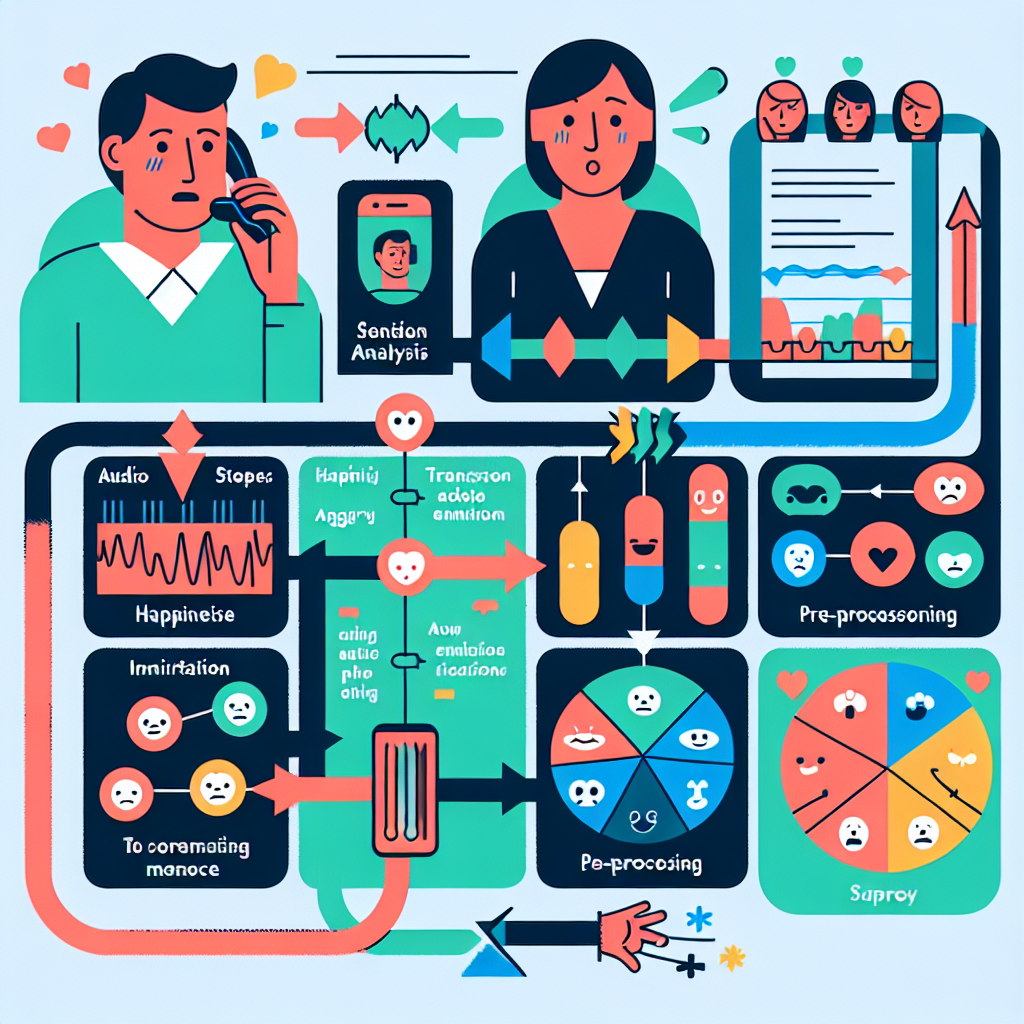
In today's fast-paced and digitally connected world, understanding your customer's emotions through their expressions can be complex. Thanks to advancements in technology, we have what is known as Sentiment Analysis. This technology uses artificial intelligence to interpret and classify emotions in textual data, primarily derived from verbal and tonal cues during phone-based customer interactions. Its real-time functionality allows businesses to detect customer sentiments instantly, enhancing the overall customer service experience. IBM defines sentiment analysis as "the use of natural language processing, text analysis, computational linguistics, and biometrics to systematically identify, extract, quantify, and study affective states and subjective information."

Sentiment Analysis can pick up various feelings, including joy, frustration, excitement, or anger, by analyzing the tone and context of the conversation. This not only allows the business to handle customer queries effectively but also helps in troubleshooting problems efficiently in real-time. Moreover, tracking these emotions over time can give valuable insights into improving the company's products, services, and overall customer journey.
By catalyzing the customer feedback loop, sentiment analysis improves customer relations and drives business growth. Companies can pinpoint areas of dissatisfaction, fine-tune marketing strategies, personalize customer experiences, and transform their businesses using the power of sentiment analysis. Thus, it turns customer interactions on phone calls into actionable insights, fostering a stronger bond with customers and enhancing brand loyalty.
In conclusion, deploying sentiment analysis in real-time phone-based customer interactions offers endless possibilities. It helps to enrich the customer experience, crafting a more emotionally resonant and personalized approach that is sure to win customer hearts.
In the ever-evolving realm of customer service, staying ahead of the curve is paramount. An increasingly popular tool for enhancing customer interaction within business phone systems is real-time sentiment analysis. This innovative application of artificial intelligence extracts, identifies, and assesses the sentiments (emotions) inherent in customers' verbal cues, facilitating personalized interaction within customer service departments.
The most direct impact of this technology is a dramatic improvement in customer satisfaction. Studies indicate that customers appreciate being heard and understood, with real-time sentiment analysis providing the framework for this connection. Misunderstandings or disconnects, often causes of customer discontentment, can be bypassed as service representatives gain instant insight into customer sentiment and tailor their responses accordingly.
High customer satisfaction often leads to higher retention rates, another significant benefit of real-time sentiment analysis. Customer loyalty is hinted to be directly correlated with the degree of personalization they receive from a service. Real-time sentiment analysis equips businesses with the tools to offer highly personal experiences, fostering loyalty. Incorporating feedback loops reinforces commitment to customer satisfaction and compels customers to maintain their association with the business.
Perhaps the most significant advantage to businesses is the personalized customer service experience this technology provides. Service representatives can adapt their tone, language, and approach based on real-time sentiment cues, creating a bespoke interaction for each customer. This not only improves problem resolution efficiency, but also boosts the perceived customer-centricity of the business.
In conclusion, real-time sentiment analysis is not merely another technological advancement in the realm of customer service. It is a game-changer with incredible benefits encompassing improved customer satisfaction and retention, as well as personalized service experiences. Businesses seeking to elevate their customer service levels can no longer afford to ignore this tool in their arsenal.
Adapting your customer service department for the digital age requires not just dedication and proper training, but increasingly, the integration of Artificial Intelligence (AI) tools like sentiment analysis. The path to improved phone-based customer interactions begins with integrating sentiment analysis capabilities into your existing phone systems, transforming them into smart, emotionally aware systems.

Before considering the technical integration, it's important to understand what sentiment analysis can achieve. In essence, sentiment analysis, often likened to opinion mining, is a text analysis method that uses Natural Language Processing (NLP) to determine the tone—whether positive, negative, or neutral—behind words.
Integrating this technology with your phone systems begins with assessing your current infrastructure. Whether you have an analogue, digital, VoIP, or cloud-based phone system, you must take the time to understand its capabilities and limitations. Talk to your provider about APIs or SDKs that can be used for integrating third-party applications. This will involve aspects of telephony and computer integration (CTI) as a foundation.
Next, you'll need to choose a sentiment analysis service. Many options on the market offer robust capabilities, but not all will be suitable for your unique needs. Look for an AI service that offers real-time analysis, high accuracy rates, comprehensive language support, and scalability.
Once the right service is chosen, your technical team or service provider will be able to lay the groundwork for the technical integration. This could involve setting up AI-powered machine learning models for understanding intent and sentiment across different languages. The integration should ensure that the AI system can tap into live conversations, analyze the sentiment behind words, and supply real-time insights to your customer service representatives while they are on a call.
Post-integration, it's vital to provide training to your staff on the effective utilization of sentiment analysis insights during live interactions. This powerful AI tool can give them an edge, allowing for more effective and empathetic conversations with customers, potentially resulting in improved satisfaction scores and boosting customer relations overall.
Sentiment Analysis, especially in real-time, has already been embraced by various industries to significantly improve phone-based customer interactions. With several success stories to support this approach, it underpins how crucial understanding customer sentiment is for better results, rapport-building, and customer satisfaction.
The telecommunication sector serves as a shining example. Firms like Hypertech Solutions have adopted real-time sentiment analysis tools for a better and prompt understanding of customer emotions during phone interactions. By identifying negative emotions early, Hypertech could quickly adjust their responses accordingly to prevent customer dissatisfaction. As a result, they reported a noticeable dip in their complaint rates and an increase in customer satisfaction scores.
Equally compelling is the case of a leading staffing firm, the ATR International. They used sentiment analysis tools capable of detecting 22 different feelings, such as frustration, excitement, and disappointment, during phone interactions. The real-time analysis not only aided in addressing any issues immediately but also helped in developing personalised strategies for different customers. Post implementation, ATR International saw a 33% increase in customer retention rates.
Lastly, in the finance sector, leading banks such as HDFC Bank had deployed real-time sentiment analysis on phone-based customer interactions. They mined valuable insights from customer's tone, voice pitch, and choice of words to determine the customer's sentiment. Based on the real-time input, HDFC bank was able to improve their customer service response, bringing a significant boost in customer loyalty and a considerable reduction in their attrition rates.
These case studies illustrate that adopting real-time sentiment analysis for phone-based customer interactions can help businesses across various sectors address concerns promptly, build a stronger relationship with customers, and foster positive business outcomes. It's a potent tool in today's business landscape, which is primarily focused on superior customer experience and satisfaction.
While real-time sentiment analysis has the capability to revolutionize phone-based customer interactions, its implementation is not without challenges. Companies embarking on this innovative technology journey must be ready to confront these potential bottlenecks and address vital privacy considerations.

One of the significant challenges involved is accuracy. Capturing and correctly interpreting human emotions, especially in their spoken form, is a difficult task. The spoken languages are full of nuances and subtleties and automated systems may struggle to capture this complexity effectively at times. Subsequently, misinterpretation errors can lead to inappropriate responses, damaging customer relationships.
Next, the implementation of this new technology also has cost implications. From software expenses through setup costs to staff training, companies must factor in these additional expenditures when estimating the return on investment.
Integrating real-time sentiment analysis without compromising on essential data privacy regulations is another hurdle to overcome. Businesses should ensure to align their sentiment analysis system with the stringent data privacy frameworks like the General Data Protection Regulation (GDPR).
Lastly, companies may encounter resistance to the new technology adoption due to cultural factors within their organizations. Keeping their teams informed about the benefits and potential challenges of implementing sentiment analysis could foster a conducive environment for change.
In summary, implementing real-time sentiment analysis in telephone-based customer interactions has several challenges to address. While these should not deter businesses from embracing technological advancements, understanding and smartly managing these issues will be critical to successfully transitioning towards improved customer engagement.
In the changing landscape of customer service, phone-based interactions continue to play an essential role. With future advancements in technology, we can expect these interactions to become more sophisticated and intuitive. One such advancement is the increasing utilization of sentiment analysis in real-time, powered by artificial intelligence (AI) and machine learning (ML).
Artificial Intelligence and machine learning algorithms have empowered firms to analyze and handle customer interactions with greater precision in real time. In the future, advancements in these technologies promise to enhance phone-based customer services, thereby improving user experience and increasing customer satisfaction. The role of AI and ML in sentiment analysis can thus not be overstated.
Real-time sentiment analysis uses machine learning to form an understanding of an individual’s emotions through their words. By instantaneously analyzing and evaluating the tone, context, and language of a phone-based customer interaction, businesses can understand customer sentiment and tailor their responses accordingly.
Further advancements in AI and ML might bring even more profound changes in the near future. For instance, predictive analytics might be used to anticipate customer needs and take proactive measures. AI could be used to predict potential issues and address them even before the customer has to call in for help, thereby providing quicker resolutions and enhancing the overall customer experience.
Changes in the industry indicate a shift towards greater use of sophisticated AI and ML algorithms in customer service applications such as sentiment analysis. Nonetheless, it's essential that businesses continue investing in these technologies to improve real-time analysis and better handle customer interactions. The future of phone-based customer interactions is undoubtedly intertwined with the rise of AI and ML in sentiment analysis.
Start your free trial for My AI Front Desk today, it takes minutes to setup!








